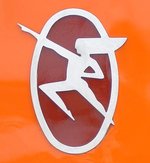Hiawatha (Amtrak)
|
|
Hiawatha (or the Hiawatha Service) is the name of a train route operated by Amtrak on the western shore Lake Michigan, though the name was historically applied to several different routes that extended across the Midwest and out to the Pacific Ocean. As of 2004, fourteen trains (seven round-trips) run daily between Chicago, Illinois and Milwaukee, Wisconsin, making intermediate stops in Glenview, Illinois and Sturtevant, Wisconsin. The line is partially supported by funds from the state governments of Wisconsin and Illinois. It is one of the most heavily-used routes in the entire Amtrak system, aside from rail lines on the United States East Coast and in California, and the train has the best on-time service record of any in the Amtrak system. A one-way trip takes about 90 minutes.
| Contents |
Historical service
Historically, the trains were operated by the Milwaukee Road and traveled from Chicago to the Twin Cities in Minnesota. The first Hiawatha trains ran in 1935. By 1945, there were actually three routes carrying the Hiawatha name:
- Twin Cities Hiawatha – the main route to Minnesota
- North Woods Hiawatha – a spur route off the main line leading from New Lisbon, Wisconsin to Minocqua, Wisconsin
- Midwest Hiawatha – a separate line westward across Illinois and Iowa to Sioux Falls, South Dakota and Omaha, Nebraska (the line split into two parts in Manilla, Iowa).
The Twin Cities Hiawatha ran twice daily in each direction, with morning and afternoon trains. In 1947, the Olympian line from Chicago to the Pacific Northwest was renamed the Olympian Hiawatha. This train ceased operations on May 22, 1961. From that time until Amtrak there was a Morning Hiawatha that operated between Chicago and Minneapolis. Over the entire time, the very distinctive tail vehicle on Hiawatha trains was an observation car known as a Skytop Lounge.
From June 5, 1971 until October 1, 1979, there was a service known as North Coast Hiawatha that ran from Chicago, Illinois, to Seattle, Washington. The train's route followed the historic Milwaukee Road route as far west as the Twin Cities, and then continued to Seattle largely using the historic transcontinental route of the Northern Pacific Railway via Bismarck, North Dakota, and Billings, Montana. The "North Coast Hiawatha" train name was an amalgam of the old "Olympian Hiawatha" name, and the North Coast Limited, the name of a former Northern Pacific train. For most of its history, the Chicago–Seattle line ran three times weekly, although daily service was provided during some summer seasons. The Chicago–Twin Cities Hiawatha route ran once a day.
Early on, the Hiawatha trains were pulled by steam locomotives, though the trains were by no means slow. In fact, these vehicles were some of the fastest steam engines ever built, with schedule times on some routes requiring speeds of well over 100 miles per hour (160 km/h). Some believe that these trains may have broken the official steam locomotive speed record set by the Mallard, as the trains were said to exceed 120 mph (193 km/h) on a regular basis.
Future service
Some have advocated that the current Amtrak line be extended to Madison—or even all the way back to the Twin Cities—and converted to high-speed rail. Such a conversion would probably happen as part of the Midwest Regional Rail Initiative, which would improve rail lines between several Midwestern cities, using Chicago as a hub. The Hiawatha service would probably be boosted to about 110 miles per hour (177 km/h) from the current speed of 79 mph (127 km/h), reducing current Milwaukee to Chicago trip times by about 25 minutes. However, this remains an unlikely possibility for the foreseeable future.
A project to connect the line to Milwaukee's General Mitchell International Airport began in 2004 and is expected to be complete by the end of the year. The station will serve passengers transferring to and from airliners and rail-only travelers as well.
See also
- Hiawatha, the Native American leader after whom the route is named
- Hiawatha Line, a light rail corridor in Minneapolis, Minnesota
- Hiawatha (disambiguation) for other uses of the name
External link
- Amtrak's Hiawatha page (http://www.amtrak.com/servlet/ContentServer?pagename=Amtrak/am2Route/Vertical_Route_Page&c=am2Route&cid=1081256321481&ssid=133)
References
- John Kelly (June 5, 2001). Amtrak's Beginnings. (http://www.trains.com/Content/Dynamic/Articles/000/000/001/123clbam.asp) Classic Trains magazine. Accessed May 28, 2004.
- Mike Ramsey (May 27, 2004). Amtrak tracks budget feud. (http://www.lincolncourier.com/news/04/05/27/c.asp) The Lincoln Courier. Accessed May 28, 2004.
- (1945). Hiawatha (advertisement). (http://wx4.org/to/foam/big_rr/milw/vintage/ads.html) Accessed July 5, 2004.

